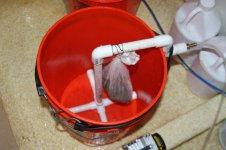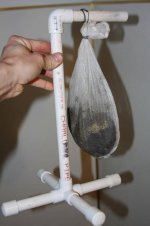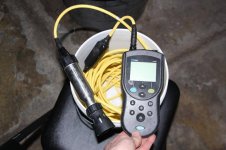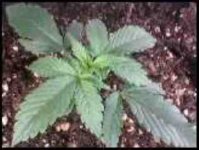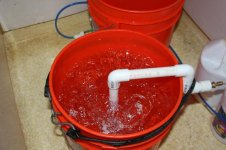SpicySativa
Member
What's up everyone?
So... I wanted to start up a thread to document my various microbe related experiments.
I built myself a compost tea brewer roughly following MicrobeMan's recommendations on his website (Microbeorganics.com). Here's what I've got:
~5-gal Homer Bucket
~EcoPlus Air 1 Commercial diaphragm pump
~Home-built 3/4" PVC diffuser in an "X" design with two 1/16" holes drilled in each "leg" of the "X".
~Adjustable aquarium heater
~pH meter (kindof a crappy one, but reasonably accurate)
~Hach Dissolved Oxygen Meter (very accurate)
~Various worm castings, ammendments, etc.
~High hopes of greatness (which science does not always allow)
I assembled my brewer and gathered the following ingredients for a 4.5-gallon batch of AACT.
~1.5 cup of worm castings from the local worm farm (fed composted horse manure, coffee grounds, and "various food waste")
~2 TBSP kelp meal
~1 TBSP soft rock phosphate
~4 TBSP Eco-Hydro Fish Hydrolysate
~2 TBSP Hi-Brix molasses (Earth Juice brand)
The compost, kelp meal, and rock phosphate went into a 1-gal paint strainer bag suspended in the brew, the rest was mixed into the water. Here's how it went:
6:30 PM - Fire up the pump, begin brewing
pH = 4.3
DO = 9.92 mg/L
Temp = 15.1 *C (kinda cold...)
8:50 PM - pH = 4.9
DO = 8.84 mg/L
Temp = 21.4 *C (the heater did it's thing)
7:15 AM - pH = 5.6
DO = 8.42 mg/L
TEMP = 21.0 *C
6:30 PM - pH = 6.2
DO = 1.10 mg/L (BAD BAD BAD BAD BAD!!!)
Temp = 21.6 *C
I double and triple checked that dissolved oxygen reading, but it was the sad sad truth... That's the thing about science experiments, you don't always discover what you want to.
So... I'm back to the drawing board, and hopefully you guys can help me out. I need to figure out how to coax enough dissolved oxygen from this EcoPlus pump to keep my brew AEROBIC!
I suspect my problem might be the large size of the bubbles this thing produces. Sure it's cranking a lot more air than my old fish tank aerator and air stones, but I bet it had LESS bubble surface area than my old setup...
So what'ya think?
Or maybe I used too much food for my brewing temperature?
Help me brainstorm here...
So... I wanted to start up a thread to document my various microbe related experiments.
I built myself a compost tea brewer roughly following MicrobeMan's recommendations on his website (Microbeorganics.com). Here's what I've got:
~5-gal Homer Bucket
~EcoPlus Air 1 Commercial diaphragm pump
~Home-built 3/4" PVC diffuser in an "X" design with two 1/16" holes drilled in each "leg" of the "X".
~Adjustable aquarium heater
~pH meter (kindof a crappy one, but reasonably accurate)
~Hach Dissolved Oxygen Meter (very accurate)
~Various worm castings, ammendments, etc.
~High hopes of greatness (which science does not always allow)
I assembled my brewer and gathered the following ingredients for a 4.5-gallon batch of AACT.
~1.5 cup of worm castings from the local worm farm (fed composted horse manure, coffee grounds, and "various food waste")
~2 TBSP kelp meal
~1 TBSP soft rock phosphate
~4 TBSP Eco-Hydro Fish Hydrolysate
~2 TBSP Hi-Brix molasses (Earth Juice brand)
The compost, kelp meal, and rock phosphate went into a 1-gal paint strainer bag suspended in the brew, the rest was mixed into the water. Here's how it went:
6:30 PM - Fire up the pump, begin brewing
pH = 4.3
DO = 9.92 mg/L
Temp = 15.1 *C (kinda cold...)
8:50 PM - pH = 4.9
DO = 8.84 mg/L
Temp = 21.4 *C (the heater did it's thing)
7:15 AM - pH = 5.6
DO = 8.42 mg/L
TEMP = 21.0 *C
6:30 PM - pH = 6.2
DO = 1.10 mg/L (BAD BAD BAD BAD BAD!!!)
Temp = 21.6 *C
I double and triple checked that dissolved oxygen reading, but it was the sad sad truth... That's the thing about science experiments, you don't always discover what you want to.
So... I'm back to the drawing board, and hopefully you guys can help me out. I need to figure out how to coax enough dissolved oxygen from this EcoPlus pump to keep my brew AEROBIC!
I suspect my problem might be the large size of the bubbles this thing produces. Sure it's cranking a lot more air than my old fish tank aerator and air stones, but I bet it had LESS bubble surface area than my old setup...
So what'ya think?
Or maybe I used too much food for my brewing temperature?
Help me brainstorm here...

